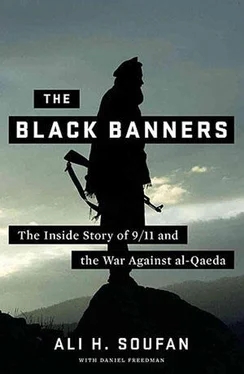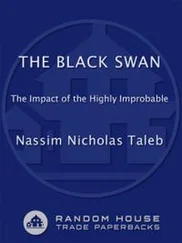Qutb joined the group shortly after Banna’s death and through it met Colonel Gamal Abdel Nasser and other military leaders plotting to overthrow King Farouk. They were looking for allies, and the Brotherhood, with its strong support among the lower classes, seemed ideal. Together the military officers and Brotherhood leaders carried out the successful 1952 coup.
While both groups wanted to replace the king, their ideas for what should come next differed, with Nasser planning a secular government (and championing the idea of Arab nationalism) and the Brotherhood seeking an Islamic government (and pushing political Islam). Although it was Nasser who took power after the king’s fall, he offered Qutb a position in the cabinet, as minister of education. Qutb declined, saying that the position wasn’t senior enough for him, and began publicly challenging the regime, calling for an Islamic state.
In 1954 a member of the Brotherhood, Mohammed Abdel Latif, attempted to assassinate Nasser, firing eight shots at him from twenty-five feet away. All of them missed. While panic broke out in the assembled crowd, Nasser remained calm and simply declared: “If Abdel Nasser dies… each of you is Gamal Abdel Nasser… Gamal Abdel Nasser is of you and from you and he is willing to sacrifice his life for the nation.” The crowd cheered him and the event was widely reported across the country, causing Nasser’s popularity to soar. He used the opportunity to crack down on the Brotherhood, throwing many members, including Qutb, in jail.
Qutb was reportedly severely tortured, and the experience drove him to write his most influential work, Milestones — Ma’alim fi al-Tariq —which he had friends and family smuggle out of prison and circulate. In the book, he argues that according to Islam only God has sovereignty, and that for an ordinary person such as Nasser to serve as sovereign is the equivalent of idolatry. Such a system, Qutb writes, results in jahiliyya —the state of ignorance that preceded the life of the Prophet Muhammad. To Qutb, the modern state and Islam were incompatible, and those behind the modern state were pulling Muslims in the wrong direction.
Qutb’s doctrine held that those who tortured him and his fellow prisoners, and indeed any citizens of the state (who by implication authorized the torture), could not be real Muslims—no real Muslim would inflict torture on another. Therefore, he argued, the torturers were kafirs, or nonbelievers, deserving of a sentence of apostasy, or takfir .
The background to sentencing someone as a kafir lies in the mid-seventh century, when Imam Ali, the Prophet’s son-in-law, decided, as caliph, to compromise with a political opponent rather than engage in a war. His action prompted a rebellion by the Kharijites, who assassinated Ali and declared that only they were the true Muslims—all others were apostates and must be put to death. The Kharijites called themselves al-Shurat (“the buyers”), a reference to their buying a place for themselves in the next world. Kharijites (“those who went out”) was the name given to the group by other Muslims because of their extreme views. Charges of apostasy and other measures imposed by the Kharijites had no scriptural basis: according to the Quran, only those who worship idols and who persecuted the Prophet and the early Muslims can be considered apostates. Hence the Kharijites took to manipulating Quranic passages and Islamic doctrine to justify their deeds.
Qutb also drew on radical thinkers such as the Pakistani Sayed Abul A’ala Maududi, his contemporary, and much earlier figures, such as Ibn Taymiyyah. One target of Ibn Taymiyyah’s theological wrath was the Arab Muslims’ Mongol conquerors, converts to Sunni Islam. He charged them with apostasy and declared, furthermore, that anyone who dealt with them or even so much as stood near them when they were being attacked could be killed—even if they were pious Muslims. His rationale was that if the bystanders were sinful Muslims, then it was fitting that they were killed, and if they were devout Muslims and unworthy of death, they’d simply go straight to heaven—thus no harm would be done by killing them. Either way, according to his logic, the killers were committing no sin by killing bystanders.
One doesn’t have to look far in Islamic theology to see how wrong this view is: the Quran states that anyone who kills an innocent person shall be treated “as if he had murdered all of mankind.” That refers to any human being, regardless of religion. It also states: “As for anyone who kills a Muslim deliberately, his repayment is Hell, remaining in it timelessly, forever. God is angry with him and has cursed him, and has prepared for him a terrible punishment.” To this day Ibn Taymiyya’s arguments are used by takfiri terrorists—those who accuse other Muslims of being apostates—to justify the killing of innocent people. Some who subscribe to it don’t have enough knowledge of Islam to know how wrong it is, and others knowingly misuse it to justify violence.
Qutb was hanged in 1966. Beforehand, the regime offered him mercy on the condition that he recant his views, but he refused, allegedly telling his sister, “My words will be stronger if they kill me.” He surely was right in that sense, as his ideas have been used by everyone from Khomeini to bin Laden. Khomeini was fond of employing Qutb’s imagery and conceptual arguments: just as Qutb, for example, compared Nasser (whom he viewed as a tyrant) to Pharaoh, Khomeini likened the shah to the biblical Pharaoh, and by his logic whoever challenged the Pharaoh took on the role of Moses. Given Khomeini’s international prominence as the leader of Iran, his use of Qutb’s ideas and arguments gave them wide circulation in the Muslim world.
In March 1979, one month after the Iranian revolution, Egypt and Israel signed the peace treaty that formally completed the Camp David Accords of the previous year. In the Middle East, the agreement was seen as a betrayal of the Palestinians and undermined the Arab world’s solidarity against Israel. As a consequence, Egypt faced isolation throughout the Muslim and Arab world and was suspended from the Arab League. Islamist radicals in Egypt were enraged: Sadat, in the years before his assassination by extremists in 1981, had tried to sell himself as a religious president, in contrast to Nasser, who battled the Islamists and imprisoned Qutb.
On November 4, 1979, Iranian students attacked the U.S. Embassy in Tehran, taking fifty-two Americans hostage in retaliation for the United States’ having allowed the shah into the country for cancer treatment. The failed U.S. rescue attempt in April resulted in the hostages being scattered around Iran; they were not released until January 1981—444 days after they had been seized. While the student leaders who overran the embassy hadn’t sought Khomeini’s approval before they acted, he supported them once it became clear that they were loyal Islamists who had pledged fealty to him. For the duration of the 444 days, the United States under Jimmy Carter seemed powerless to respond, and the forces of political Islam appeared to be on the rise.
Sixteen days after the attack on the embassy, on November 20, the destruction of a holy place shook the Islamic world when extremists seized al-Masjid al-Haram and took pilgrims hostage. The mosque surrounds the Kaaba, which is said to have been built by Abraham and is the place that Muslims turn to face when they pray five times a day. It is considered the first house of worship and the holiest site in Islam. The extremists declared that the Mahdi, the redeemer of Islam, had arrived—it was one of their leaders—and called on Muslims to obey him. Using the Grand Mosque’s loudspeaker system, which could be heard throughout Mecca, they announced that the Saudi leadership had been corrupted by the West and demanded that the monarchy be replaced, that all ties with the West be cut, and that a stricter version of Islamic law be introduced into the country.
Читать дальше












